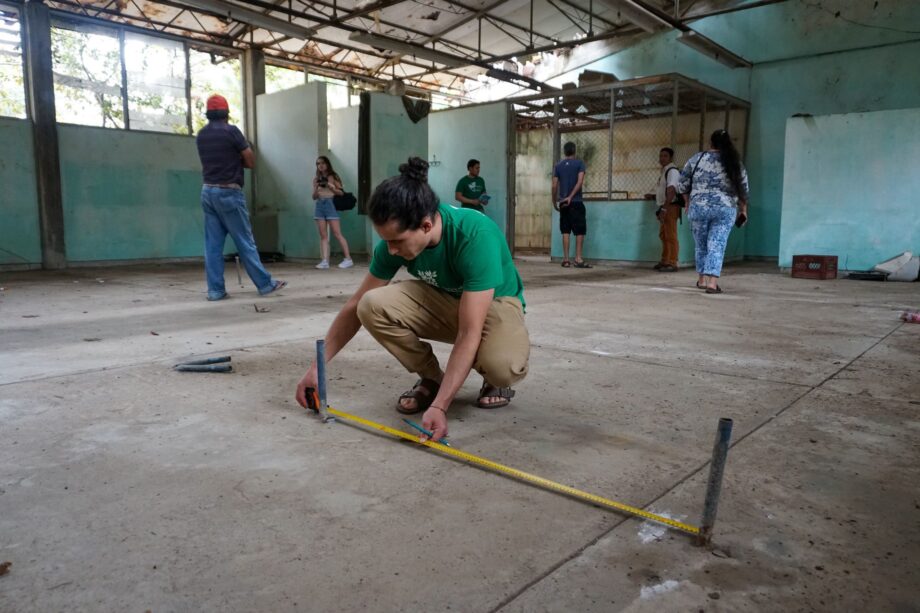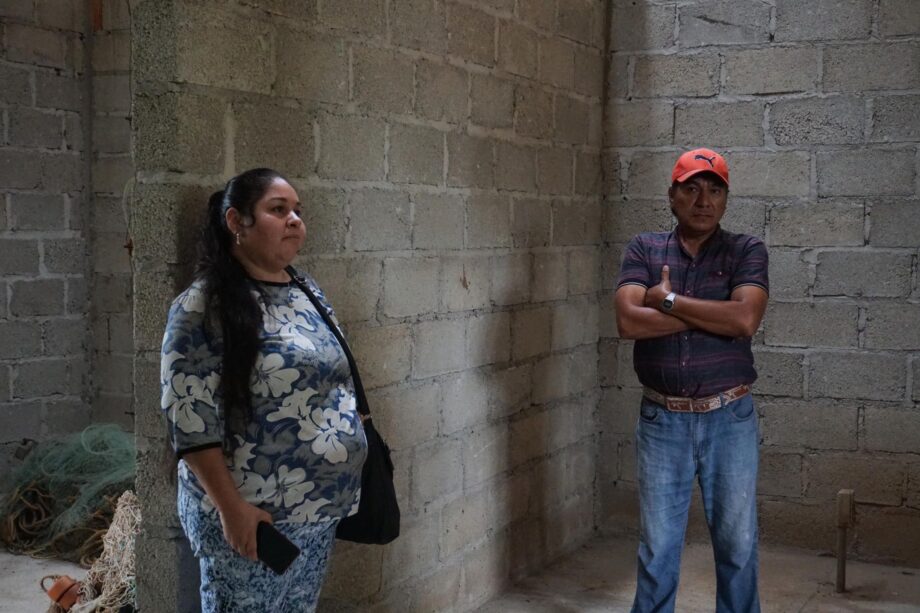
Maya Piedra, GPJ Mexico
Víctor Venegas, vice president of the parents committee of Mar Patrimonial Technical Secondary School, looks at the school’s classrooms from the outside in San Francisco, Nayarit.
SAN FRANCISCO, MEXICO — Hours after her students go home, science teacher Cynthia Cervantes settles in for a long night: She and her 6-year-old son shuffle into a computer room closet and drift to sleep on a shared mattress. They live at the school during the workweek — making meals with a blender and microwave, washing themselves in a school restroom and storing their clothes in cardboard boxes — and travel to their hometown, 120 kilometers (75 miles) away, on weekends and holidays. So do five of the school’s nine other teachers. So do three maintenance workers. So did the principal before he left the job. They can’t afford anywhere in town.
Mar Patrimonial Technical Secondary School is in San Francisco, on the glittering stretch of coastline known as Riviera Nayarit. In recent years, housing costs have soared beyond the paychecks of many educated professionals. Teachers often face a wrenching choice: live at the school or leave. Many eventually choose the latter. In the last three years, the school hasn’t had instructors at various points for biology, Spanish, physics, history, math, English and art, among other subjects.
Other schools face the same problem. In Sayulita, just 7 kilometers (4 miles) south of San Francisco, maintenance workers and 1 out of 7 teachers live in the local secondary school, Revolución Mexicana — which started the school year in August without English teachers, says professor Patricia Duarte. She adds that, usually, those who don’t have family in the area try to pool resources to share a house, or count on the solidarity of locals who offer a room for a token rent.
Students worry that the churn is robbing them of knowledge they’ll need to ace university entrance exams. In 2022, Casandra Abigail Cárdenas Delgadillo, 13, carried the Mexican flag during the local parade commemorating the Mexican Revolution anniversary, an honor reserved for top students. But when Mar Patrimonial’s chemistry position went vacant during the 2021-2022 school year, Casandra simply didn’t learn the material — instead, she kept the grade she had before the teacher left and was advanced to the next level. “I’m nervous because I feel like I haven’t learned everything I should have,” Casandra says.
Parents fumed, and in November 2022, around 40 of them staged a protest in front of the school. State education officials quickly filled the vacancies, but within weeks, more teachers had departed. “We hope that these vacant positions are filled soon so that we can avoid these problems that cause students to suffer,” says Mar Patrimonial’s former principal, José Manuel Hernández, who left the position at the end of the 2022-2023 school year, shortly after his interview with Global Press Journal.





Meanwhile, parents are spearheading an effort to repurpose an abandoned building at the school as on-site housing for teachers and stop the turnover. They’ve partnered with architecture and engineering students at the Technological Institute of Superior Studies of the West, a university in neighboring Jalisco state, and plan to apply for federal funding through a program called La Escuela es Nuestra, which directs financing directly to specific schools, as well as fundraise with the local community. They aim to build a model dormitory this semester, but they’re unsure whether the project will take off at all.
The school’s woes are the result of two larger issues: a disorganized and inefficient education system, and an exceptionally expensive local housing market.
Riviera Nayarit is one of the fastest-growing tourist destinations in Mexico. The number of international arrivals in Puerto Vallarta’s airport, the region’s main hub, nearly doubled between 2012 and 2022. For many locals, the influx of sun seekers has brought more job opportunities, but not wealth or stability. On the employment page of the government website of Bahía de Banderas, the municipality where San Francisco and Sayulita are located, most of the available jobs are for maids, hostesses, bartenders, waiters’ helpers, drivers and maintenance workers.
Meanwhile, rents are skyrocketing. A report by Tinsa, a real estate consultancy, identified an average increase in 2022 in the price per square meter of residences in Nayarit of 19.9%, more than double the national average of 8.2%.
Even former Principal Hernández, who had a full-time salary, couldn’t find a place to live. He used to sleep in the school administrative office on an inflatable mattress that he deflated every morning, and showered in a bathroom stall. “If I rented my own place, I wouldn’t be able to support my children’s university education,” he says.
In Mexico, teachers’ salaries vary according to location (there are more than 1 million nationally; more than two-thirds are women). Those who work in high-cost areas usually earn more. In San Francisco, however, salaries haven’t kept up with how fast living costs are increasing. In addition, secondary school teachers are paid by the hour, and for reasons most teachers don’t understand, almost none in Bahía de Banderas work full time.





While Mexican basic education teachers work, on average, 31 hours a week, according to the National Institute of Statistics and Geography, Cervantes is only assigned 18 hours. That shakes out to a monthly salary of less than 10,000 Mexican pesos (about 560 United States dollars). In San Francisco, that covers about a month’s rent, with little left over for food, transportation and other bills.
Ivett López, in charge of admissions for Nayarit in the Unidad del Sistema para la Carrera de Maestras y Maestros (USICAMM), the government body responsible for assigning teachers to schools, says that if teachers “want to earn more, they should [apply to take] additional hours, but it’s a process to do so,” referring to the periodic exams the USICAMM conducts to recruit teachers. López adds that a full-time salary, for 42 hours of work a week, “is a good salary” in Nayarit.
When asked about the system’s inefficiency in assigning subjects to teachers, López says, “Several departments are involved, there are structures to be checked, how many classes [each school] has, how many teachers [it] needs to have. We [at USICAMM] are merely mediators.”
The Nayarit branch of the Department of Public Education did not reply to multiple requests for an interview.
Duarte, the Sayulita teacher, says she has sat these periodic exams many times but is always assigned hours that aren’t compatible with her current classes, without explanation. “They don’t assign it [correctly] because they don’t want it,” she says.



For María de los Ángeles Navarrete, the San Francisco representative of the Bahía de Banderas teachers union, and a history teacher at Mar Patrimonial herself, local teachers probably need to earn at least 25,000 pesos (about 1,390 dollars) a month to live decently in the area.
But for Cervantes, even if she worked 28 hours a week at her current rate, her salary still wouldn’t reach 20,000 pesos (1,110 dollars) a month. So, with the permission of state education officials, she and her son stay at the school. She loves her teaching job, and it’s the only way she can keep it. But “it is not the same as being in your own house,” she says.
Navarrete also lives in an improvised room in Mar Patrimonial. It’s not unusual for teachers offered a job in Riviera Nayarit to turn it down, she says. “You arrive, there is nowhere to live, and you get to an area where the salary you earn as a teacher is not enough.”
Rigel Jassiel Ku, delegate secretary of the teachers union in Guadalajara, the capital of Jalisco state — whose beach resort, Puerto Vallarta, adjoins Bahía de Banderas — believes authorities need to revise the program of a municipality’s public schools (there are 30 in total in Bahía de Banderas) so that teachers are allocated more efficiently and fairly among them.
Meanwhile, parents rush to help their children catch up with their studies before they reach university-entrance age. Elizabeth Carrillo Reyes, a member of Mar Patrimonial’s parents committee, has a son in his third year, a daughter in her second, and a nephew in first. Her third-grade son wants to study electrical engineering. At the time of the interview, there was neither a technology nor an English teacher. “‘Mom, we need to do more study and more research,’” she says her son tells her. Meanwhile, the town’s problems are inspiring her daughter to study education. “She is worried for the next generation,” she says.







